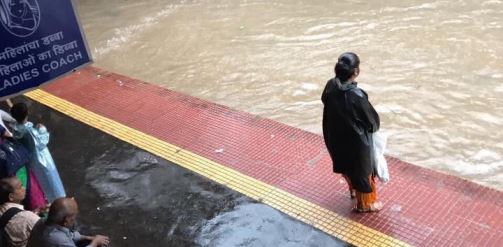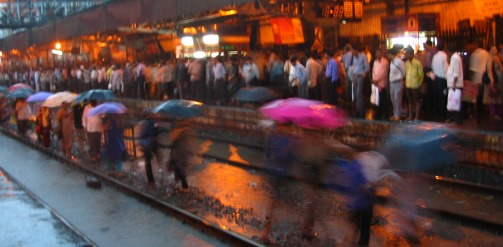Dramatic images of the impacts from flooding from Houston in the US and Mumbai, India have called to attention the vulnerabilities that an increasingly urbanised world faces in the twenty first century.

As Houston was inundated by ‘biblical’ rainfall and grapples with extreme flooding and its aftermath, another coastal megacity on the other side of the globe also experienced destructive flooding, albeit on a lesser scale. Within the span of a couple of hours, rainfall to the tune of 298 mm, lashed Mumbai. Public life ground to a complete standstill, with a number of deaths and casualties reported. It also conjured up people’s memories of the most devastating urban flooding in India’s recent history, the ‘deluge’ of Mumbai in 2005, wherein record rainfall (944 mm within 24 hours) precipitated a disaster that caused hundreds of fatalities and massive economic damages.
The complex picture of this disaster is bigger than climate change
Climate change, in both the cities cases, is held in parts responsible for precipitating more intense and extreme weather events that contribute to disasters. On the other hand, scientific uncertainties remain regarding how far climate change can be held accountable for specific regional or local weather events.
While it is tempting to lay the blame for flooding squarely on ‘unusual’ precipitation, the picture that emerges on the ground is often more complex and messy. This is the picture in Mumbai as documented by our project, the Climate Change, Uncertainty and Transformation project based at the Norwegian University of Life Sciences in partnership with the Institute of Development Studies, the Indian Institute of Technology-Bombay and others.
Following the 2005 Mumbai floods, many promises were made, and investments undertaken by municipal authorities to ensure better flood proofing of the city. However, more than a decade later, the dominant approaches of urban governance and development have not changed much at all and chronic waterlogging and flooding remain a yearly occurrence.

The disappearance of flood plains and patches, protective mangrove cover, coastal wetlands, and massive infrastructure expansion on the fragile coastline continue unabated. Major drainage channels remain obstructed and sky-high real estate prices drive contractors to appropriate and develop land in low-lying and flood prone zones. All of these aggravate threats from natural disasters and reveal a structurally unequal city wherein the poor, who constitute a large proportion of the city’s population, regularly face the brunt from the double impacts of development interventions (e.g displacement, loss of livelihoods) and flooding.
Flood mitigation strategies in Mumbai rely dominantly on built-up infrastructure (e.g pump stations, embankments, renovating storm water drains) but, as evidenced yet again, have had only very limited success. Often, these interventions serve to shift points of inundation from one area to another, creating new vulnerable hotspots. Arguably, improvements in immediate disaster response have taken place but they tend to function inefficiently.
What lessons can be learnt from the recent Mumbai floods?
Poor uptake of information from early warning systems contributed to ordinary people being caught totally unaware this time around. In the face of such adversity, Mumbaikars and commentators comment with pride on the Mumbai spirit and resilience, which allows things to bounce back to normal quickly. While commendable, this can translate into a lack of protest and also serve as an excuse for state authorities to do nothing. In addition, the ‘spirit of Mumbai’ discourse hides larger inequalities in disaster impacts and outcomes. What lessons do these recent experiences hold then?
Coastal megacities such as Mumbai have emerged as centres for population growth, wealth accumulation, and valuable material assets. At the same time, they are becoming increasingly vulnerable to extreme weather events, natural disasters and climatic changes. Investing in and modifying urban cityscapes appropriately is a long-term exercise with potential lock-in effects, necessitating great diligence.
The recent events in Mumbai illustrate that addressing flood threats can’t be separated from wider urban development trends, strategies of environmental management and linked uncertainties. The reliance on techno-managerial means to ‘control flooding’ is alluring, but ultimately only constitutes a tinkering of variables that preserves a status quo and detracts from the complex political, ecological and social landscape of the city. In this context it is important to adopt a more expansive, cautionary and communicative approach to urban governance.
This requires a mobilisation of a wide range of actors, from citizen groups, NGOs to experts as well as institutions and governance mechanisms across scales. Urban planning needs to be more attuned to local geography and ecology, with plans for spatial expansion tailored accordingly. There is also a need to ‘politicise’ disasters so that the political class is forced to act and engage with their constituencies to mitigate risks and hazards.
All of these are challenging exercises that require radical rethinking and reorganisation.
In Houston’s, as in Mumbai’s case, experts point to deficiencies in land use planning and governance as being partly responsible for the outcome of the disaster. As India and other parts of the world rapidly urbanise, these events signal the urgent need for a transformative agenda in urban planning and governance. They also provide an opportunity to learn and incorporate lessons, so that growing cities can avoid costly mistakes. The extent of rainfall cannot be controlled, but responses and management of it certainly can.
—
Photo credits: Mumbai floods – 2017: Amrita Sen; Mumbai floods – 2005: Ashwan Lewis/Flickr – Creative Commons Licence